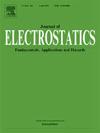含水率和摩擦充电条件对废塑料实际颗粒混合物摩擦-静电分离的影响
IF 2.1
4区 工程技术
Q3 ENGINEERING, ELECTRICAL & ELECTRONIC
引用次数: 0
摘要
摩擦静电分离是一种简单、经济、环保的方法,可以对世界各地积累的、需要回收的废旧电子电气设备(WEEE)中含有的不同塑料进行分类。在WEEE中发现的各种塑料中,丙烯腈-丁二烯-苯乙烯(ABS)和聚苯乙烯(PS)由于其优异的绝缘和机械性能而最普遍,使其成为电气和电子设备(EEE)工业中必不可少的材料。然而,它们相似的表面性质和相近的质量密度值极大地限制了湿法分离方法,如泡沫浮选和沉浮法。之所以选择摩擦静电分离而不是湿法,是因为它是一种干法,不需要化学预处理,不需要昂贵的润湿试剂,同时也消除了废水处理问题。这种方法利用了ABS和PS摩擦电性能的差异,使它们在不改变化学结构的情况下分离,这对保持可回收性至关重要。本研究的目的是评估影响两阶段摩擦静电工艺效率的几个因素(含水量、粒径、摩擦充电条件)的影响,该工艺用于处理由大约55%的丙烯腈-丁二烯-苯乙烯(ABS)、38%的聚苯乙烯(PS)和7%的其他颗粒状废塑料组成的混合物。加热混合物显著降低了颗粒的含水量,这不仅提高了摩擦充电效率,而且大大改善了自由落体静电分离过程的结果。在旋转圆筒式装置中摩擦充电过程的持续时间和产生静电分离器电场的电极系统的配置是影响该过程效率的另外两个因素。经过第一阶段的静电分离,回收了74%的ABS颗粒,产品纯度为94%。采用两级分离方案,可以回收82%的PS,纯度为88%。流化床摩擦充电器比旋转圆柱式装置效率更高。在最佳操作条件下,ABS产品的纯度和回收率分别提高到97%和95%。本文章由计算机程序翻译,如有差异,请以英文原文为准。
Influence of moisture content and triboelectric charging conditions on the tribo-electrostatic separation of actual granular mixtures of waste plastics
Tribo-electrostatic separation is a simple, cost-effective, and environmentally friendly method to sort the different plastics contained in the ever-increasing quantities of waste electrical and electronic equipment (WEEE) accumulated all over the world and needing recycling. Among the various plastics found in WEEE, Acrylonitrile Butadiene Styrene (ABS) and Polystyrene (PS) are the most prevalent due to their excellent insulating and mechanical properties, making them essential in the electrical and electronic equipment (EEE) industry. However, their similar surface properties and close mass density values significantly limit wet separation methods, such as froth flotation and sink-float methods. Tribo-electrostatic separation was chosen over wet methods because it is a dry process that requires no chemical pretreatment, no expensive wetting reagents, while also eliminating wastewater treatment issues. This method exploits the differences in triboelectric properties of ABS and PS, enabling their separation without altering their chemical structure, which is critical for preserving recyclability. The aim of the present study was to evaluate the effects of several factors (moisture content, particle size, triboelectric charging conditions) that affect the efficiency of a two-stage tribo-electrostatic process employed for processing a mixture consisting of roughly 55 % Acrylonitrile Butadiene Styrene (ABS), 38 % Polystyrene (PS), and 7 % of other granular waste plastics. Heating the mixture significantly reduced the moisture content of the particles, which not only enhances the triboelectric charging efficiency but also considerably improved the outcome of the free-fall electrostatic separation process. The duration of the triboelectric charging process in a rotating-cylinder type device and the configuration of the electrode system that generates the electric field of the electrostatic separator are two other factors that influence the efficiency of the process. After the first stage of electrostatic separation, 74 % of the ABS particles were recovered in a 94 % pure product. Using a two-stage separation scheme, it was possible to recover 82 % of the PS, with a purity of 88 %. A fluidized bed triboelectric charger was found to be more efficient than the rotating-cylinder-type device. Under optimal operating conditions, the purity and recovery of ABS product increased to 97 % and 95 %, respectively.
求助全文
通过发布文献求助,成功后即可免费获取论文全文。
去求助
来源期刊

Journal of Electrostatics
工程技术-工程:电子与电气
CiteScore
4.00
自引率
11.10%
发文量
81
审稿时长
49 days
期刊介绍:
The Journal of Electrostatics is the leading forum for publishing research findings that advance knowledge in the field of electrostatics. We invite submissions in the following areas:
Electrostatic charge separation processes.
Electrostatic manipulation of particles, droplets, and biological cells.
Electrostatically driven or controlled fluid flow.
Electrostatics in the gas phase.
 求助内容:
求助内容: 应助结果提醒方式:
应助结果提醒方式:


